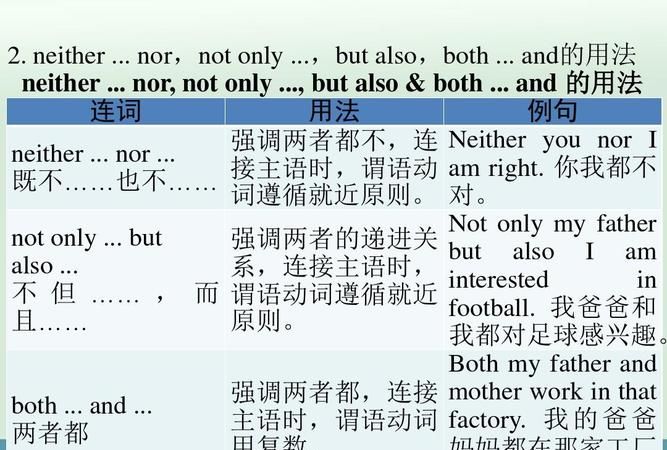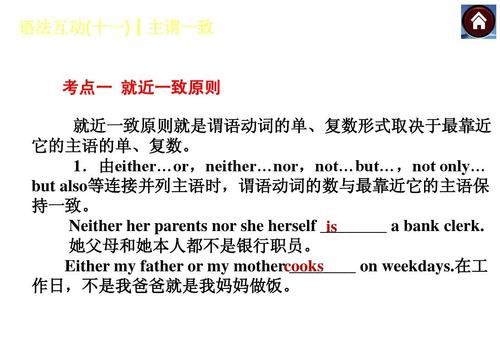本文目录
neithernor和eitheror后面谓语动词的用法
就近原则即句子的谓语动词的单复数与nor或者or后面的名词的单复数决定,下面举两个例子。
Neither you nor Tom likes running.(你和Tom都不喜欢跑步)该句子中谓语动词like的单复数与nor后面的人称保持一致。
Either the apple or the pear is OK.(苹果和梨都可以)该句子的谓语动词是第三人称单数,与or后面的pear保持一致。

非正式文体
有时依“就近一致原则”,但也可依“意义一致原则”或严格地依“语法一致原则”。
例句:
Neither she nor I were there. (意义一致) 我和她当时都不在那儿。(非正式)
Neither she nor I was there .(就近一致)(译文同上句)(正式)
但是,如果依“就近一致原则”而与其他两项原则相矛盾时,则常常认为是不太合符规范的。
eitherorneithernorasasnot soas的就近原则怎么用
就近原则即:谓语与靠近的名词、代词(有时不一定是主语)在“人称、数”上一致。
用的时候分两种情况:
I.
在正式文体中:
1.由下列词语连接的并列主语:"there be+句型; or ; either …or;nor; neither…nor;whether…or;not…but; not only…but also" ; 等。e.g. ①What he does or what he says does not concern me . 他的行为或言谈都与我无关。 ②Neither you nor I am wrong . 你和我都没错。 ③Not you but your father is to blame . 不是你,而是你父亲该受责备。 ④Not only you but(also) he is wrong .不仅你错了,他也错了。
2. 在倒装句中:谓语可与后面第一个主语一致。e.g. ①In the distance was heard the clapping of hands and the shouts of the people . 在远处,能听见鼓掌声和人们的呼喊声。 ②There is (are) a pen and some books on the desk .桌上有一支钢笔和几本书。
II.
非正式文体中: 有时依“就近一致原则”,但也可依“意义一致原则”或严格地依“语法一致原则”。e.g. Neither she nor I were there (意义一致) 我和他当时都不在那儿。(非正式) Neither she nor I was there .(就近一致)(译文同上句)(正式) 但是,如果依“就近一致原则”而与其他两项原则相矛盾时,则常常认为是不太合符规范的。e.g. No one except his own supporters agree with him .仅他自己的支持者同意他的意见。(依“就近”和“意义”一致的原则;但语法上,“No one ”才是主语,谓语要改成“agrees”。“写作中”一般要依“语法一致”原则。

both and
or, either…… or……, neither……nor……, not only……but also 等符合就近原则。as well as, accompanied by, including, in addition to, more than,together with符合就远原则。both,and不是就近也不是就远,属于并列关系。
1、就近原则
就近原则也称“邻近原则”“就近一致原则”(Proximity),即:谓语与靠近的名词、代词(有时不一定是主语)在“人称、数”上一致。
例子:
Either you or he knows something about the task.
要么你,要么他知道此任务的相关情况。
2、就远原则
就近原则就是谓语动词的变化,即:谓语动词与前面主语一致。
例子:
Scientists should be literate and articulate as well as able to handle figures.
科学家除了要能处理数字,还应该具有文学素养和善于表达。
3、并列关系
连接并列主语时,若意义为复数,则后面谓语用复数;若表示的是单数意义,后谓语用单数。
例子:
My mom and my dad love me.
我的爸爸妈妈都很爱我。

扩展资料:
not only……but also详解:
not only……but also
发音:英 [nɒt ˈəʊnli bət ˈɔːlsəʊ] 美 [nɑːt ˈoʊnli bət ˈɔːlsəʊ]
含义:不仅……而且
用法:
1、not only … but also应连接两个相对称的并列成分。例如:
He plays not only the piano but also the violin.
他不仅弹钢琴,还拉小提琴。(连接两个宾语)
2、not only …but also 连接两个分句,并且 not only /until位于句首时,第一个分句中的主语和谓语要部分倒装。例如:
Not only does the sun give us light but also it gives us heat.
太阳不仅给了我们光明,也给了我们热量。
反义疑问句有就近原则吗
Neither……nor……当然遵循就近原则。
现在的语法观点跟以前有些不太一样了,更强调从读者的角度去理解。也就是说,你读出来是什么意思,就偏向这个意思。
就近原则基本上也是因为这个才产生的。当然也是为了表达方便。
顺便给你一个学习方法:现在资料信息可及性大大提高。凡是碰到难的句子或者语法,不妨多找一些该词组的句子,自己概括、归纳,这样就更容易掌握一些。

以上就是关于neither or的用法就近原则 ,neithernor和eitheror后面谓语动词的用法的全部内容,以及neither or的用法就近原则 的相关内容,希望能够帮到您。

